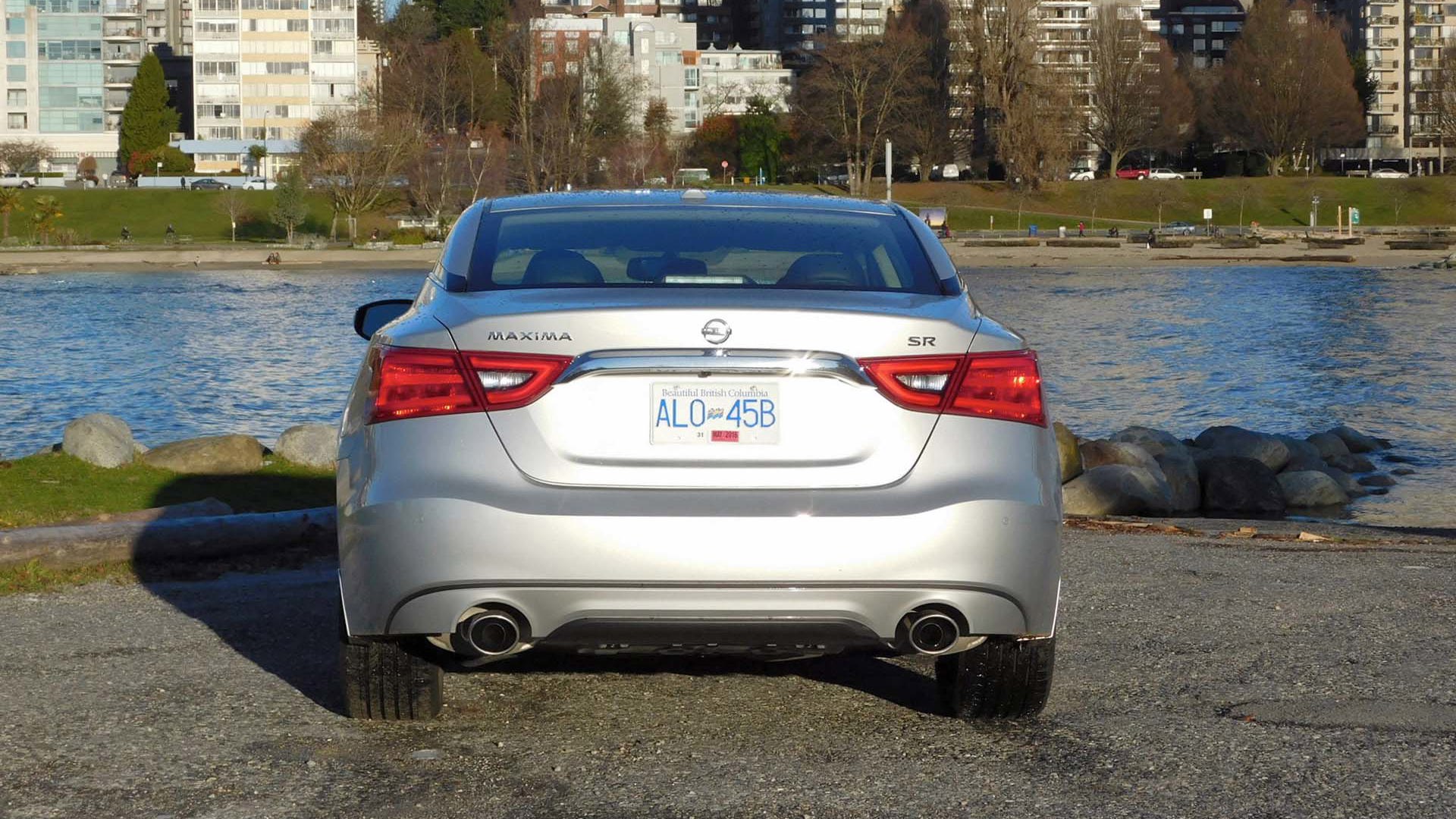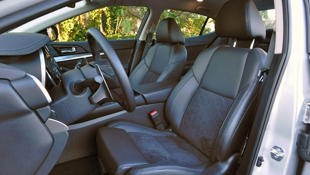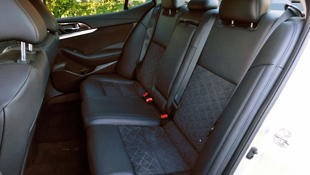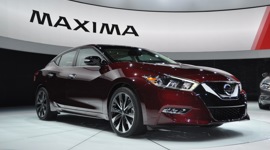 AutoTrader SCORE
AutoTrader SCORE
-
INTERIOR9/10
-
EXTERIOR STYLING7/10
-
FUEL ECONOMY6/10
-
PERFORMANCE8/10
-
COMFORT9/10
Re-imagined and redesigned for the 2016 model year, Nissan's flagship Maxima sedan is car that resists easy definition. Nissan calls it a "4-Door Sports Car" and goes so far as to emboss "4DSC" on the taillights and headlights. But the thing is, with its front-wheel drive layout and CVT automatic it's never going to fit in as a true sports car, not really, no matter the number of doors.
Between the deeply curved beltline profile, the big V-motion grille, the boomerang headlights, the "floating" roof and the multitude of angular details everywhere else, the new Maxima has a lot going on.
So what is it? You could call it a bigger, better-equipped and somewhat more athletic version of the Altima and you wouldn't be wrong (although the Altima actually has greater interior volume – go figure). You could call it a sport oriented near-luxury front-wheel drive sedan and you'd be pretty close to the mark. It's officially a mid-size car but it's long, wide and low, with a footprint not much smaller than Toyota's full-size Avalon. In terms of price point my SR trim test car came in close to the base price for a BMW 3 Series, and while it may lack the smaller BMW's luxury badge (not to mention the 3 Series' properly sports car-like choice of rear-wheel drive or all-wheel drive and manual transmission or lighting-fast conventional automatic) it comes instead with significantly more interior room and with equipment levels that would easily cost an additional $15,000 in the BMW.
The closest true competitors for the Maxima are perhaps the Buick LaCrosse, Acura TLX and Volkswagen CC. All of these, like the Maxima, are luxury-oriented mid-size sedans for those who want something that's a little more than your basic family sedan, but who still desire practicality and don't want to break the bank. And measured against these cars, the Maxima stacks up nicely indeed.
Externally, Nissan decided to give the 2016 Maxima not just a little more style than your average sedan, but a great big helping more style, and then a dollop more on top of that. Between the deeply curved beltline profile, the big V-motion grille, the boomerang headlights, the "floating" roof and the multitude of angular details everywhere else, the new Maxima has a lot going on. It's 33 mm lower and 56 mm longer than the previous generation car, and Nissan calls its look "futuristic." What you make of it will depend on your own personal taste (I thought it looked a bit like a hatchback or fastback when I first saw it), and I heard equally from both the love-it and hate-it crowds during the week I had the car. Regardless of which camp you fall into, however, you've got to give Nissan credit for being bold enough to bring many of its Nissan Sport Sedan Concept features into production.
Sporty Shenanigans: Why it’s Hard to Crash the Nissan Maxima
Inside the Maxima, Nissan promises a "premium, above-class" experience, and here the designers have certainly delivered – at least in my SR trim test car. The Maxima cabin is a marvellous place to spend time. In terms of materials the lower dash and door panels are rigid plastic, but everything else is built from soft-surface materials, with a genuine stitched upper dash, cloth-wrapped pillars, and high-end materials such as Alcantara suede. I really liked the suede-on-leather look of the SR interior and I was thoroughly smitten by the diamond-creased polished aluminum trim across the dashboard and doors – it's both unique and classy, and the pattern was picked up with subtle blue diamond stitching in the suede seat inserts. I got a chance to sit in a Platinum trim version of the car and noted that it has the same diamond-crease trim, but executed (and I do mean executed) with a woodgrain finish that looked completely incongruous on the patterned trim surface. Win some, lose some, I guess.
I've long been a fan of Nissan's "Zero-gravity" seats (designed using principles developed by NASA for keeping astronauts comfortable) and the Maxima SR delivers with a heated and cooled eight-way power adjustable driver's seat (including adjustable lumbar support) that proved superbly comfortable on even the longest drives. The passenger's seat (also heated and cooled) only gets four-way adjustment, but my wife found it equally comfortable nevertheless. In the back the Maxima features plenty of legroom and enough headroom for reasonably tall adults in the outboard positions. The middle seating position has a pronounced hump and so it's less roomy and comfortable, but with only four aboard the Maxima feels, as my mother-in-law put it when she was relegated to the back seat, "like riding in a limousine." Trunk space is 405 L, which is plenty big enough for most needs and a little bigger than Acura TLX, Buick LaCrosse or Volkswagen Passat (though it's shy of the 453 L trunk in the comparably priced Toyota Avalon).
Up front, the 2016 Maxima advertises its sporty intentions with a driver-oriented cockpit design that angles the centre stack towards the driver and features a flat-bottomed steering wheel (I rather liked the suede inserts on my test car's steering wheel, although I wondered how well they'd hold up in the long run when pitted against my sweaty paws). Anchoring the centre stack is an 8.0-inch colour infotainment touchscreen backed up by Nissan's new Sirius-XM powered NissanConnect system – this features smartphone integration options for Apple and Android phones, including hands-free text messaging (although apparently this particular feature is supported for Android phones only). GPS navigation and Bluetooth connectivity are standard across the range, and there are two USB inputs. My test car featured a powerful 11-speaker Bose audio system with all the expected input options (AM/FM/XM/CD/MP3/WMA), plus "Active Sound Enhancement" to quell unwanted low frequency sounds and amplify engine sounds during spirited driving (so yes, fake engine noise). Dual-zone climate control is standard, as is proximity entry, heated steering wheel, surround-view backup monitor, power rear sunshade and much more. My one quibble was the rather wide, swooping A-pillars and large exterior mirror bases which together create fairly substantial blind spots up front.
The touchscreen recognizes pinch and swipe gestures and I found it generally quite easy to use, and Nissan also provides a redundant "Display Commander" rotary knob interface on the console for those who prefer a more hands-off style of input. I didn't find the Display Commander quite so intuitive as the touchscreen, but once I got used to the way it worked it became my favoured way of controlling things (I'm not really a big fan of using touchscreens in moving vehicles, as they require significant visual attention and manual precision). In-cabin storage is well taken care of with a decent-size storage bin at the back of the console, a lockable glove box, a cubby for electronics at the front of the console, a couple of smallish door pockets, and all the expected cupholders.
Underpinning the Maxima's bodywork is a new platform that features greater use of high-strength steel, reducing the Maxima's weight by 37 kg (kudos to Nissan for this) while at the same time improving its torsional rigidity (cars flex when exposed to high cornering forces, and if you can reduce the flexing you improve cornering ability and feel). Up front the suspension uses MacPherson struts, while at the back there's an independent multilink setup with ZF Sachs monotube dampers – all great stuff to have on a sports sedan resume.
Powering the 2016 Maxima is a revised version of Nissan's familiar 3.5L VQ-series V6, which uses something like 60 percent new parts compared to the previous iteration of the engine (including new sodium-filled valves) and is rated for 300 horsepower and 261 lb-ft of torque. It's hooked up to a re-engineered Xtronic continuously-variable transmission (CVT). For the majority of buyers, it's probably sufficient to say that this gearless automatic transmission works efficiently and unobtrusively in the background, and gives the Maxima a very smooth delivery of power. Changes to the transmission for 2016 include a wider spacing between the highest and lowest ratios (for stronger acceleration and better highway economy), and new shift logic that holds revs when cornering aggressively to allow more seamless acceleration as you exit the corners. Also new in the latest Maxima is a Drive Mode Selector that adjusts throttle mapping, transmission programming and steering feel for "Normal" driving or more aggressive, higher-revving "Sport" driving.
All that said, for buyers who truly want a four-door sports car experience, the CVT remains a letdown. Not because it makes the engine drone (droning is in fact minimal because the transmission brings the engine revs up for the initial burst of acceleration and then quickly lowers them), and not because it makes the Maxima slow (it'll rip from 0-100 km/h in 6.5 seconds). Where the CVT loses out is in driver engagement and in any feeling of connectedness between the engine and the road.
Nissan does include a sport mode in the transmission that provides seven programmed virtual "gears" (really they're stepped ratios) that you can select using paddle shifters, but the shifts that result are very loosey-goosey, with the engine revs sliding up and down during each shift rather than stepping crisply from one gear to the next – the effect is probably good enough that casual drivers may not realize the Maxima has a CVT, but not good enough to fool even moderately enthusiastic drivers. Ironically the paddle shifters themselves are some of the best in the industry – big beefy alloy affairs that are mounted to the steering column rather than the steering wheel so they don't move around confusingly as you steer.
Fuel economy is rated at 10.9 / 7.8 L/100km (city/highway) but I wasn't able to duplicate those numbers in real-world driving, averaging 11.7 L/100km over a week of city-biased mixed driving. During a longer highway drive at 100 km/h on level ground I saw a best short-term average of 7.5 L/100 km with the engine ticking over at 1,600 rpm, so I'll believe the posted numbers are achievable if you can keep a lighter foot on the accelerator than I did during the week.
Handling in the Maxima is generally quite good, and when driven with a bit of restraint the SR feels pleasantly athletic. This is partly due to the fact that the SR is quite firmly sprung (significantly more so than other trim levels), and partly due to the SR's Integrated Dynamic-Control Module with Active Ride Control. Among its bag of tricks, the Active Ride Control system can touch the rear brakes after the car crests a large bump in order to reduce bounce. The brakes themselves are powerful and confidence inspiring. Where things fall short is in steering feel (I found there was precious little) and balance, especially near the limits. During hard cornering the front-drive platform pushes early and irrevocably into understeer – so it's not going to frighten anyone, but then neither does it offer much in the way of genuine thrills. I was also disappointed that the SR, which is my favoured flavour of Maxima, isn't available with the sunroof. Nissan says this is to keep the centre of gravity low and maintain maximum torsional rigidity in the sport-minded SR, but it stretches incredulity to believe eliminating the sunroof would have any noticeable benefit. A more believable explanation might be that the missing sunroof offsets the cost of some of the other SR goodies, but at any rate it's a shame Nissan couldn't offer it as an option.
That aside, with pricing starting at $35,900 before destination charges for the base S model (topping out at $43,300 for the Platinum), extensive standard equipment, and an exceptionally well-appointed interior, the Nissan Maxima stakes out a narrow but tempting territory. No, it's really not a four-door sports car despite what Nissan claims. The embossed taillight acronym makes more sense if you imagine it standing for "4 Door, Six-cylinder, Cvt." But in that context, as big-but-not-too-big near-luxury sedan with attention-getting style, a comfortable interior and genuine presence, the Maxima is definitely worth a look.
| Warranty: 3 years/60,000 km; 5 years/100,000 km powertrain; 5 years/unlimited distance corrosion perforation; 3 years/60,000 km roadside assistance Competitors: |
| Model Tested | 2016 Nissan Maxima SR |
|---|---|
| Base Price | $41,100 |
| A/C Tax | $100 |
| Destination Fee | $1,720 |
| Price as Tested | $43,055 |
|
Optional Equipment
$135 (Metallic/Pearl paint)
|
|















































